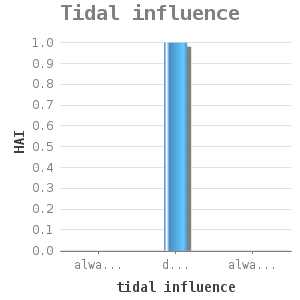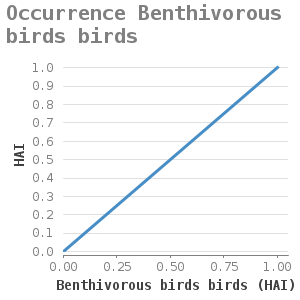H1140 - Mudflats and sandflats not covered by seawater at low tide
General
General characteristics |
|
|---|---|
Common name |
Mudflats and sandflats not covered by seawater at low tide |
Region |
The Netherlands |
Water systems |
coastal waters |
Nature parameter |
Vegetation and habitat types |
HR nr |
H1140 |
Fact sheet by |
K.E. van de Wolfshaar |
Description habitat
General occurrence
In the Netherland, mud flats and sand-flats can be found in the Wadden Sea. In the Delta region, this habitat type is called mudflats if it is connected to the main land or sandflats when completely surrounded by water #1.
Environmental boundary conditions
This habitat type includes mudflats and sandflats not covered by seawater at low tide, the so-called intertidal flats. Most intertidal flats are devoid of vascular plants, or sometimes coated by algae and cyanobacteria. Indigenous eelgrass communities are included in this habitat type (Zostera marina and Zostera noltii) #1. A large density of invertebrates occur in this habitat type, including characteristic species such as the common cockle (Cerastoderma edule), Baltic clam (Macoma balthica), Soft-shell clams (Mya arenaria), Lugworm (Arenicola marina), Ragworm (Nereis diversicolor), Sand mason worm) (Lanice conchilega) and Lugworm (Scoloplos armiger). Large concentrations of mussels can be found locally in specific habitat mussel beds. They are in fact complex communities, including mussels (Mytilus edulis), a large number of worms, crustaceans and small fish. This habitat is of particular importance as feeding ground for waders, including the Common Spoonbill (Platalea leucorhodia), Common Shelduck (Tadorna tadorna), Eurasian Oystercatcher (Haematopus ostralegus), Pied Avocet (Recurvirostra avosetta), Grey Plover (Pluvialis squatarola), Red Knot (Calidris canutus), Dunlin (Calidris alpina), Bar-tailed Godwit (Limosa lapponica), Eurasian Curlew, (Numenius arquata), Common redshank (Tringa totanus) and various kinds of gulls. During high water, the intertidal flats are a feeding ground for fish, such as the Viviparous eelpout (Zoarces viviparus), Shorthorn sculpin (Myoxocephalus scorpius), Striped seasnail (Liparis liparis), Butterfish (Pholis gunnellus), Common English flounder (Pleuronectes flesus), Fivebeard rockling (Ciliata mustela) and various goby species (Pomatoschistus). Tidal waters are also important breeding areas for fish such as Plaice (Pleuronectus platessa), Common Sole (Solea solea), Herring (Clupea harengus) and European sprat (Sprattus sprattus). Seals use the mud flats and sand flats as resting sites. Intertidal flats not covered by seawater at low tide occur in The Netherlands in the Wadden Sea area and the Voordelta near the islands of Zeeland and South Holland. For the Westerschelde and the Oosterschelde, these sand flats are part of the habitat types H1130 - Estuaries and H1160 - Large shallow inlets and bays respectively #1.
Control and growth opportunities
This habitat type is mainly sensitive to changes in velocity and flooding frequency. Mechanical damage makes this habitat unsuitable for invertebrates and their predators #1.
Dose-effect relations
Sandflats and mudflats are landscape elements that are difficult to capture with habitat factors. However, the occurrence of Benthivorous birds can be predicted with the aid of habitat factors. Therefore, this group of birds is included as an additional dose-effect relation.
Flowchart
Dose-effect relations

tidal influence |
HAI |
|---|---|
always dry |
0 |
dry during low tide |
1 |
always covered with water |
0 |
Reference: #1
Occurrence of characteristic species
The occurrence of characteristic species is beneficial for the quality of a habitat type. This applies to all above-mentioned characteristic species of, for example, invertebrates and eelgrass. Most Dutch sandflats are devoid of plants, but locally algal communities or eelgrass covering can be found. This concerns mostly Dwarf eelgrass (Zostera noltii), as Common eelgrass needs to be covered by water. Dose-effect relations for the occurrence of eelgrass is included under macrophytes (Dwarf eelgrass - Zostera noltii and Common eelgrass - Zostera marina) only available in Dutch. For a number of invertebrates, there are already dose-effect relations. These will be included in the database soon.
Mudflats and sandflats are an important feeding ground for Benthivorous birds. Therefore, the habitat suitability of this group of birds has been included as an additional dose-effect relation. The dose-effect relations of Benthivorous birds are described on the 'benthivorous birds' page only available in Dutch.

Benthivorous birds (HAI) |
HAI |
|---|---|
0 |
0 |
1.0 |
1.0 |
Reference: #2
Uncertainty and validation
These dose-effect relations have not been validated.
Applicability
To describe a landscape element according to the habitat factors is very difficult. It is more informative to determine if an area that is defined as mudflats and sandflats not covered by seawater at low tide is suitable for, for instance, Benthivorous birds. This will give an indication of the quality of the area as main feeding ground.
Example project
At present, there is no example of a project available.
References
1 http://www.minlnv.nl/natura2000
2 Haasnoot, M. en K.E. van de Wolfshaar (ed). Habitat analyse in het kader van de Planstudie/MER voor Krammer, Volkerak en Zoommeer. WL report Q4015. 2006